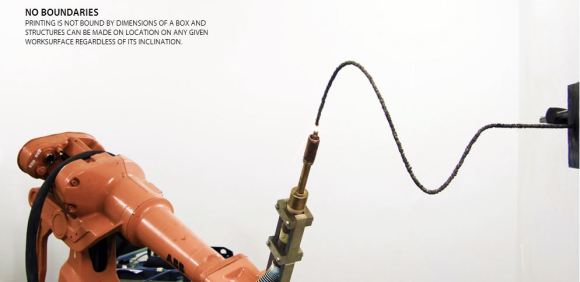
[Joris Laarman] is working on a project called the MX3D-Metal which uses an ABB industrial robot arm and a welding machine to create strong metal structures on any working surface and in any direction.
He started last year with the MX3D Resin printer, which is the exact same concept, but instead of metal, it uses a two-part epoxy that bonds instantly upon mixing. Their lab is located in Amsterdam, and they work closely with IAAC (the Institute for Advanced Architecture of Catalonia) — Autodesk provides funding for the research.
[Joris] has successfully printed complex structures using steel, stainless steel, bronze, copper, and even aluminum. Poking around their website you can find many examples of different things they have printed, including intricate matrices of multiple curved lines which end up looking more organic than mechanical. It uses mostly the same concept as the Rostock Welding robot we covered a few months ago, which is open source and fairly cheap to make at home!
Stick around for a video of both the MX3D-Metal and Resin robot printers in action!
[via Gizmodo]















The mind absolutely reels with the possibilities, both practical and…whimsical!
I sincerely hope we see more of this in the future.
Apparently my mind has the anti-reel option installed, because except for artsy fartsy fluff, I can’t think of a practical application that can’t be done quicker/better/cheaper by alternative methods.
What about on-the-go repairs to vehicles? Think of the military applications, for example. A truck hauling a large printer of this type would be able to patch entire holes in the hull of another damaged vehicle. If mounted on a small undersea drone, it could mend a submarine without either needing to surface.
If mounted to the end of a space vessel’s control arm, it could mend the ship if damage was sustained during launch or from a small collision. The same would be true for an off-planet colony would need to repair and produce components, but likely wouldn’t have factories available.
There are of course the normal comments about rapid prototyping and experimentation that one could also make about a device like this, also..
Can also be used in the aviation industry. They is already talks about the fact that 3d metal printing allows us to create new shapes and designs that would otherwise be impossible to cast / forge / machine.
Using Bucky-ball concept, we can potentially create solid structures using a tiny percentage of the original material
Give them tracks and exceptional location ability, then Swarm them and have them build an entire building automatically. 3d Printing real architecture.
Undersea / or high risk additive welding. Imagine being able to patch holes in leaking nuclear facilities, or smaller blowouts in undersea drilling.
Need to have that anti-reeling thing looked at. It can break an otherwise good maker mind and turn it into an accountant mind surprisingly quickly.
Ok, am I crazy or is anyone else thinking Tholian Web?
The epoxy one is actually more interesting to me. Doing that is what certain friends of mine would get yelled at for because they should be doing work with the welder instead of goofing off. There are practical applications for 3D-printing style work with welders, but they’re typically limited to laying down layers of weld beads at alternate angles to build up hard material that is then smoothed with a grinder. “Hardfacing”, it’s called.
So, really, putting the welding head on the end of a robot arm and doing this with it is interesting, but not really groundbreaking, as I’m given to understand the epoxy one was.
Looks like they need to incorporate voltage feedback from the MIG machine to maintain a constant arc length.
Yeah yeah, cut to the chase and make a rubbish gun with this thing and then maybe eventually we can think about a way of making solid things that are useful, like boring old cutting, folding, machining, casting, punching…
What’s new here? People have been using MIG welders to make rough metal 3d prints for decades.
Formed in place rebar for concrete. It could be done faster and with zero material waste, and the entire rebar structure would be one welded piece.
But a lot of energy waste …
Energy use will (hopefully) be a non-issue in the future :)
More likely, it will be the biggest issue.
A rolled mild steel bar will be structurally superior to this weld bead centipede :P
Nicely put, and more than likely true.
this video goes right to my fab folder
Witchcraft!
(c: Just kidding, this is awesome.
3D printing is probably the biggest money-making opportunity of the decade, an opportunity that anyone with a computer and the internet can exploit. And the best part? You don’t even need to own a 3D printer! Since 3D printing is mostly done by web-based 3D printing companies, you can make money selling physical products as if they were digital products!
http://www.youtube.com/watch?v=s9IdZ2pI5dA
’nuff said
wow
Holy shit, this is extremely awesome!
In the video close-up shots of the metal deposition, it doesn’t look like there is any wire feed. Is it being vaporized, and then propelled, or something?
The possibilities with 3D printing are absolutely amazing – this is an incredible example. I also want to see more of this in the future.